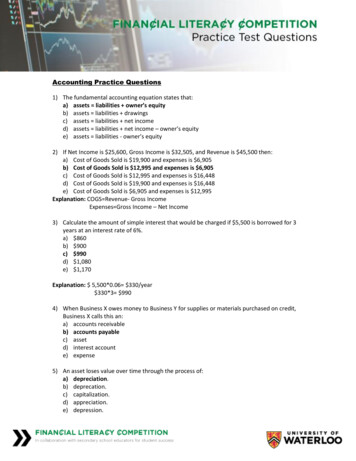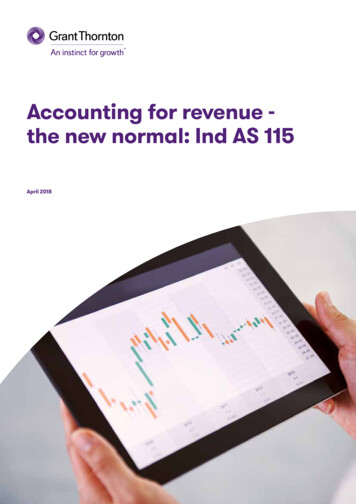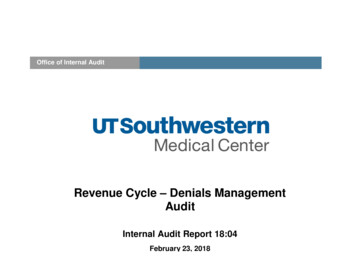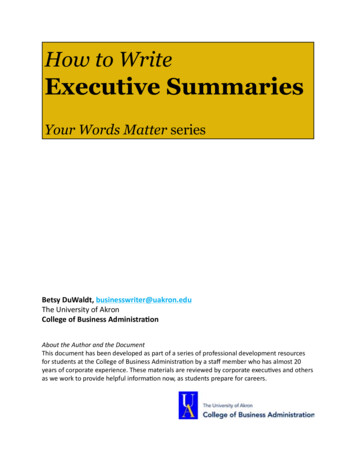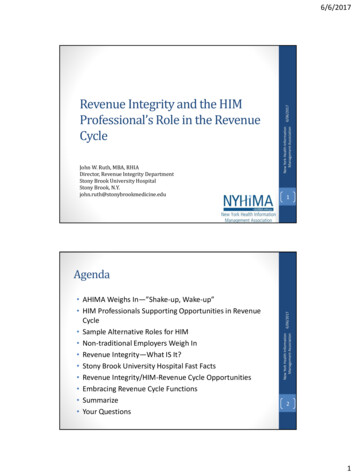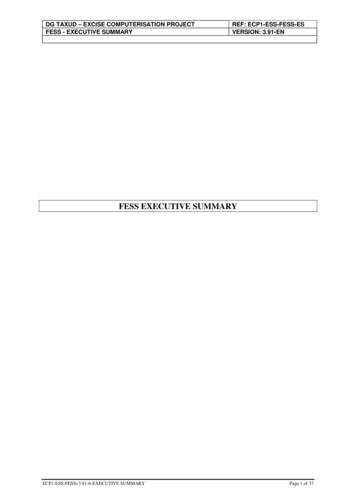
Transcription
DG TAXUD – EXCISE COMPUTERISATION PROJECTFESS - EXECUTIVE SUMMARYREF: ECP1-ESS-FESS-ESVERSION: 3.91-ENFESS EXECUTIVE SUMMARYECP1-ESS-FESSv3.91-6-EXECUTIVE SUMMARYPage 1 of 37
DG TAXUD – EXCISE COMPUTERISATION PROJECTFESS - EXECUTIVE SUMMARYDOCUMENT HISTORYREF: ECP1-ESS-FESS-ESVERSION: 3.91-ENDocument HistoryEdi.Rev.DateDescriptionAction pdated after internal reviewUAll00320/09/2004Updated after feedback DG TAXUDUAll00401/10/2004Updated after SEVE quality review, SfRUAll00510/11/2004SfR visibility check pointUAll00621/01/2005Updated after SEVE quality review, SfRUAll1021/03/2005Updated for SfAUAll10118/04/2005SfA v 1.bUAll10229/04/2005SfA verificationUAll10314/03/2006Updated for internal 20125/08/2006Corrective Maintenance following DG TAXUDrequest with MS comments received on 4/07/2006UAll20230/03/2007Internal reviewUAll202a19/04/2007Updated for internal 21117/09/2007Incorporating FESS v2.10 Workshop Decisions(ECWP 31).UAllUAllUAllSubmitted for review to DG TAXUD.21228/09/2007Incorporating DG TAXUD comments.Submitted for acceptance to DG TAXUD.21303/10/2007Implementing verification comments.Re-submitted for acceptance to DG TAXUD.21422/10/2007Submitted for review to DG TAXUD.UAll21505/11/2007Submitted for acceptance to DG TAXUD.UAll30008/11/2007Submitted for publication to DG TAXUD.UAll30126/03/2008Implementing ECWP#35 WDs and FESS KnownIssues version 1.10. Submitted for review to DGTAXUD.UAll30216/04/2008Submitted for acceptance to DG TAXUD.UAll30318/04/2008Re-submitted for acceptance to DG TAXUD.UAllECP1-ESS-FESSv3.91-6-EXECUTIVE SUMMARYPage 2 of 37
DG TAXUD – EXCISE COMPUTERISATION PROJECTFESS - EXECUTIVE SUMMARYDOCUMENT HISTORY31005/10/2009REF: ECP1-ESS-FESS-ESVERSION: 3.91-ENEvolutive Maintenance incorporating RFCs FESS001, FESS-002-REV1, FESS-004, FESS-005,FESS-007, FESS-010, FESS-011-REV1, FESS013, FESS-015, FESS-016, FESS-017, FESS-018,FESS-020, FESS-022, FESS-023, FESS-024,FESS-026-REV1, FESS-027, FESS-028, FESS029, FESS-030, FESS-031, FESS-032-REV1,FESS-033, FESS-034, FESS-035-REV1, FESS037-REV1, FESS-040 and FESS-041.UAllUAllSubmitted for review to DG TAXUD.31102/11/2009Implementing DG TAXUD comments and RFCFESS-014.Submitted for acceptance to DG TAXUD.31204/11/2009Submitted for information to DG TAXUD.UAll32011/03/2010Evolutive Maintenance incorporating RFCs FESS006, FESS-008, FESS-009, FESS-012, FESS-019,FESS-021, FESS-025, FESS-036, FESS-038,FESS-039, FESS-042, FESS-044, FESS-045,FESS-046, FESS-047, FESS-048, FESS-049,FESS-052, FESS-053 and FESS-054.UAllUAllUAllUAllSubmitted for review to DG TAXUD.32129/03/2010Implementing DG TAXUD comments.Submitted for acceptance to DG TAXUD.32212/07/2010Evolutive Maintenance incorporating RFCs FESS003-REV2, FESS-050, FESS-051, FESS-055,FESS-056, FESS-060, FESS-061, FESS-062,FESS-063, FESS-064, FESS-065, FESS-066,FESS-067 and FESS-068.Submitted for review to DG TAXUD.32326/07/2010Implementing DG TAXUD comments.Submitted for acceptance to DG TAXUD.33029/07/2010Submitted for information to DG TAXUD.UAll33129/09/2010Evolutive Maintenance incorporating RFC FESS070.UAllSubmitted for review to DG TAXUD.33204/10/2010Submitted for acceptance to DG TAXUD.--33320/12/2010Evolutive Maintenance incorporating RFCs FESS072, FESS-073, FESS-075, FESS-076, FESS-077,FESS-078, FESS-079, FESS-080, FESS-081,FESS-083, and FESS-084.UAllUAllSubmitted for review to DG TAXUD.33411/01/2011Implementing DG TAXUD comments.Submitted for acceptance to DG TAXUD.34017/01/2011Submitted for information to DG TAXUD.UAll34104/02/2011Removal of implementation of RFC FESS-080.UAllUAllRe-submitted for information to DG TAXUD.34205/01/2012Evolutive Maintenance incorporating RFCs FESS085, FESS-086, FESS-089 and FESS-095.Submitted for review to DG TAXUD.ECP1-ESS-FESSv3.91-6-EXECUTIVE SUMMARYPage 3 of 37
DG TAXUD – EXCISE COMPUTERISATION PROJECTFESS - EXECUTIVE SUMMARYDOCUMENT HISTORYREF: ECP1-ESS-FESS-ESVERSION: 3.91-EN34320/01/2012Submitted for acceptance to DG TAXUD.UAll35030/01/2012Submitted for information to DG TAXUD.UAll35115/06/2012Evolutive Maintenance incorporating RFCs FESS057, FESS-071, FESS-074, FESS-087, FESS-088,FESS-090, FESS-091, FESS-092, FESS-093,FESS-094, FESS-096, FESS-097, FESS-099,FESS-100, FESS-101, FESS-102, FESS-103,FESS-104, FESS-105, FESS-106, FESS-107,FESS-108, FESS-110, FESS-111, FESS-112,FESS-113, FESS-114, FESS-116, FESS-117,FESS-118, FESS-122, FESS-123, FESS-124,FESS-125, FESS-126 and FESS-127.UAllSubmitted for review to DG TAXUD.35209/07/2012Submitted for acceptance to DG TAXUD.UAll36011/07/2012Submitted for information to DG TAXUD.UAll36124/09/2012Incorporating internal review comments and MSverification comments:UAllUAllUAllUAll Update of Rule025 (Appendix D) to add theitems ‘37 Movement verification requestreasons’ and ‘38 Movement verificationactions’; Implementation of Commission Positions #4and #8 on MS verification comments for FESSv3.60.Submitted for information to DG TAXUD.36229/10/2013Evolutive Maintenance incorporating RFCs FESS128, FESS-129, FESS-133, FESS-134, FESS-135,FESS-136, FESS-138 and FESS-139.Submitted for review to DG TAXUD.36313/11/2013Implementing DG TAXUD comments.Submitted for acceptance to DG TAXUD.36419/08/2014Evolutive Maintenance incorporating RFCs FESS059, FESS-121, FESS-131, FESS-132, FESS-140,FESS-141, FESS-142, FESS-143, FESS-144,FESS-145, FESS-146, FESS-147, FESS-148,FESS-149, FESS-150, FESS-151, FESS-152,FESS-153 and FESS-154.Submitted for review to DG TAXUD.36516/09/2014Submitted for acceptance to DG TAXUD.UAll36631/05/2016Evolutive Maintenance incorporating RFCs FESS161, FESS-162, FESS-163, FESS-164, FESS-165,FESS-170, FESS-171, FESS-172, FESS-173,FESS-174, FESS-175, FESS-178 and FESS-180.UAllSubmitted for review to DG TAXUD.36716/06/2016Submitted for acceptance to DG TAXUD.UAll36809/08/2016Evolutive Maintenance incorporating RFCs FESS199, FESS-203 and FESS-204.UAllUAllSubmitted for review to DG TAXUD.36916/08/2016Submitted for acceptance to DG TAXUD.ECP1-ESS-FESSv3.91-6-EXECUTIVE SUMMARYPage 4 of 37
DG TAXUD – EXCISE COMPUTERISATION PROJECTFESS - EXECUTIVE SUMMARYDOCUMENT HISTORY37007/09/2016REF: ECP1-ESS-FESS-ESVERSION: 3.91-ENEvolutive Maintenance incorporating RFCs FESS156, FESS-157, FESS-158, FESS-159, FESS-160,FESS-166, FESS-167, FESS-169, FESS-176,FESS-179, FESS-181, FESS-182, FESS-183,FESS-184, FESS-185, FESS-186, FESS-187,FESS-188, FESS-189, FESS-190, FESS-191,FESS-192, FESS-193, FESS-194, FESS-195,FESS-196, FESS-197, FESS-198.UAllSubmitted for review to DG TAXUD.38026/09/2016Submitted for acceptance to DG TAXUD.UAll38119/12/2016Submitted for Information under correctivemaintenance to DG TAXUD.UAll38224/03/2017Corrective Maintenance incorporating RFCs FESS202, FESS-205, FESS-206, FESS-207, FESS-208,FESS-209.UAllUAllSubmitted for Information to DG TAXUD.38908/10/2018Evolutive Maintenance incorporating RFCs FESS201, FESS-210, FESS-211, FESS-212, FESS-213,FESS-214, FESS-215, FESS-216, FESS-217,FESS-218, FESS-219, FESS-220, FESS-221,FESS-222, FESS-223, FESS-224, FESS-225,FESS-226, FESS-227, FESS-228, FESS-229,FESS-230, FESS-231, FESS-232, FESS-233,FESS-234, FESS-235, FESS-236, FESS-237,FESS-238, FESS-239, FESS-240, FESS-241,FESS-242, FESS-243.Submitted for review to DG TAXUD.39029/10/2018Submitted for acceptance to DG TAXUD.UAll39113/12/2018Incorporating MS verification comments.UAllSubmitted for acceptance to DG TAXUD.(*) Action: I Insert, R Replace, U Update, D deleteECP1-ESS-FESSv3.91-6-EXECUTIVE SUMMARYPage 5 of 37
DG TAXUD – EXCISE COMPUTERISATION PROJECTFESS - EXECUTIVE SUMMARYTABLE OF CONTENTSREF: ECP1-ESS-FESS-ESVERSION: 3.91-ENTable of contents1 . Executive Summary . 71.11.21.31.41.51.61.71.8Scope of EMCS . 7Conception of the FESS . 7EMCS business circuit . 8Follow-up and administrative cooperation. 10SEED (System for Exchange of Excise Data) and reference data . 11Non-functional requirements . 12Fallback and Recovery Specification (FRS) . 13Analysis of similarities between EMCS and NCTS . 132 . Résumé . 172.12.22.32.42.52.62.72.8La portée de EMCS . 17La FESS et sa conception . 18Circuit métier d’EMCS . 18Suivi et coopération administrative . 21SEED (Système d’Echange des Données d’Accises) et données de références . 22Les exigences non fonctionnelles . 24Spécifications de Repli et de Reprise (FRS) . 24Analyse des ressemblances entre EMCS et NSTI . 253 . Kurzfassung . 273.13.23.33.43.53.63.73.8Anwendungsbereich des EMCS . 27Aufbau der FESS . 28EMCS-Geschäftskreislauf . 29Weiterverfolgung und administrative Kooperation . 31SEED (System zum Austausch von Verbrauchsteuerdaten) und Referenzdaten . 32Nichtfunktionelle Anforderungen . 33Spezifikation für Sicherung und Wiederherstellung (FRS) . 34Analyse der Ähnlichkeiten zwischen EMCS und NCTS . 35ECP1-ESS-FESSv3.91-6-EXECUTIVE SUMMARYPage 6 of 37
DG TAXUD – EXCISE COMPUTERISATION PROJECTFESS - EXECUTIVE SUMMARYEXECUTIVE SUMMARY1REF: ECP1-ESS-FESS-ESVERSION: 3.91-ENExecutive SummaryThe Functional Excise System Specification (FESS) analyses and documents allbusiness functions and processes that must be part of the Excise Movement and ControlSystem (EMCS). The FESS is therefore none other than the cornerstone of the wholesystem construction.In the course of the process, the FESS has been kept as close as possible to itscounterpart of the New Computerised Transit System (NCTS), i.e. the FTSS (FunctionalTransit System Specifications). There are many differences, however. In addition,EMCS must be in a position to run with and without NCTS for economic operators whoare not directly concerned by Customs formalities. EMCS will be built on the samebusiness processes and information exchange principles as NCTS, but technologies andtools used for that purpose will have to be assessed thoroughly.The present Executive Summary is intended for managing executives and also for anyperson interested in acquainting him/herself with the main features of EMCS. Thefollowing topics are addressed in turn: the scope of EMCS, the FESS and its conception,the core business circuit, the follow-up and collaboration activities, SEED (System forExchange of Excise Data) and reference data, non-functional requirements, fallback andrecovery specification, and finally a comparison between EMCS and NCTS.1.1 Scope of EMCSAccording to Decision n 1152/2003/EC of the European Parliament and of the Councilof 16 June 2003 on computerising the movement and surveillance of excisable products,the two major objectives of the planned EMCS are:(a)to permit the electronic transmission of the accompanying document provided forin Regulation (EEC) No 2719/92, and the improvement of checks;(b)to improve the functioning of the internal market, by simplifying the intraCommunity movement of products under Excise duty suspension arrangements,and by affording Member States the possibility of monitoring the flows in realtime and of carrying out the requisite checks where necessary.In addition, EMCS data are considered a basic material to help in combating fraud.Council Directive 2008/118/EC of 16 December 2008 on the general arrangements forproducts subject to Excise duty and on the holding, movement and monitoring of suchproducts is the basic text from which the business case has been analysed.EMCS exclusively addresses the movements, called under duty suspension, that aredocumented in the Administrative Accompanying Document described in Regulationn 2719/92. It does not cover the other movements, commonly named duty paidmovements, for which the simplified accompanying document is described in Regulation(EEC) n 3649/92.1.2 Conception of the FESSThe FESS has been conceived in application of the following reference documents:ECP1-ESS-FESSv3.91-6-EXECUTIVE SUMMARYPage 7 of 37
DG TAXUD – EXCISE COMPUTERISATION PROJECTFESS - EXECUTIVE SUMMARYEXECUTIVE SUMMARYREF: ECP1-ESS-FESS-ESVERSION: 3.91-EN the applicable legislation; the Feasibility Study accepted by DG TAXUD on 17 March 2000 and its Addendumaccepted by the Excise Committee on 3 April 2003 (CED N 394 rev 1); the outcome of a Reflection Group that met between 23 January and 3 June 2004, thework of which is summarised in the Final Report CED N 474-EN; threecomplementary Reflection Groups met between 30 May and 13 July 2005, between14 March and 3 October 2006 and between 10 January and 16 March 2007.The Reflection Group chose to explore the functionality as widely as possible, withoutlimiting its work to the mere framework of the existing regulation. Consequently, a partof the proposed functionality analysed hereafter depends on further legal changes thatcannot be taken for granted yet. However, the FESS takes into account the temporaryuncertainty of the outcome of the coming legislative process thanks to its modularityand the division of the functionality into use cases.From sources listed above, a first inventory of user requirements was gathered, and theywere translated into a series of use cases. One calls “use case” an ordered (notnecessarily sequential) and uninterruptible set of actions performed by a group ofinteracting actors, that takes and leaves all entities handled in a stable state.Together, the use cases cover the whole spectrum of the required functionality, not onlyprocesses to computerise, but also semi-automatic and (paper-based) manual ones. Theadvantage of use cases as an analytical tool is that they constitute a complete andconsistent set of specification.Other representations of the functionality complete the FESS, namely State TransitionDiagrams that highlight the evolution of entities such as an e-AD manipulated bybusiness processes, and messages that document the exchanges of information in thecourse of often complex transactions between actors of the system.1.3 EMCS business circuitThat part of functionality, also dubbed the “core”, is made up of all functions thatencompass the movements of Excise goods under duty suspension.A movement is documented by means of the successive states of the electronicAdministrative Document (e-AD) at each location, from issuance by the consignor toacknowledgement of receipt by the consignee.1.3.1 Origin of a movementAccording to the legislation, the origin of an EMCS movement is always a taxwarehouse. However, the Reflection Group considered the procedure of authorisingExcise movements under duty suspension to depart from a Customs office of import, soas to let goods just imported directly move under Excise duty suspension.Most generally, the tax warehouse of dispatch is owned (or managed) by the consignor(authorised warehouse keeper); however, a given MSA (Member State Administration)is entitled to allow an authorised warehouse keeper to use a tax warehouse of which heis not the owner (or manager).ECP1-ESS-FESSv3.91-6-EXECUTIVE SUMMARYPage 8 of 37
DG TAXUD – EXCISE COMPUTERISATION PROJECTFESS - EXECUTIVE SUMMARYEXECUTIVE SUMMARYREF: ECP1-ESS-FESS-ESVERSION: 3.91-EN1.3.2 Destination of a movementThere are various destinations possible for a movement: the normal destination is a tax warehouse of which the owner (or manager) is theconsignee of the movement, premises of a registered consignee as defined in Directive 2008/118/EC; in thatcase, the place of delivery is supposed to be the premises of the consignee; subject to definite limitations, the consignor need not to fill in the destination fieldsin application of Article 22 of Directive 2008/118/EC; the destination remains thenunknown; the destination must be identified later, before delivery of goods; any address duly approved by the MSA, under the responsibility of an authorisedwarehouse keeper or of a registered consignee; this is known as direct delivery; premises of a temporary registered consignee, i.e. a person or company whoobtains a temporary authorisation to receive a given quantity of goods under thecover of a specific guarantee of payment; premises of an organisation exempt of payment of duties in application of Article12 of Directive 2008/118/EC; a Customs office of export, in the case of an export operation where the goods areput under Customs export procedure, but remain under the Excise movementguarantee until they leave the territory of the Community at an office of exit.1.3.3 Core business functionsBelow is considered a series of business functions which are activated during themovement life cycle, according to well-defined business rules. So as to translate thesefunctions into specifications, several use cases will be defined in Section II of the FESS.The business functions are: Submitting an e-AD is electronically achieved by the consignor. It is automaticallyvalidated by the MSA of dispatch. As soon as it is checked valid, it is electronicallydisseminated to the MSA of destination. It reaches then the consignee and, possibly,any other interested operator. When the consignee has no connection to EMCS, eitherthe MSA of destination or the consignor informs him. Cancelling an e-AD is possible as long as the goods have not left the tax warehouseof dispatch or the place of importation. Since there is no signal at the very momentgoods are dispatched, cancellation of an e-AD is worth a careful follow up by theMSA of dispatch. Alerting with a possibility of rejecting an e-AD is possible for the consignee uponreceipt of the electronic record. This allows him informing not only the consignor butthe concerned MSAs as well that the submitted message does not correspond to theexpected contents; Updating the e-AD is the sole responsibility of the initial submitter of an e-AD.Moreover, the authorised changes concern mainly destination (consignee and/orplace of delivery). In particular, it is forbidden to change the description of goods assoon as the e-AD has been validated. Receiving goods: the consignee, or another actor on his behalf, submits a “report ofreceipt” on which possible anomalies including shortages or excesses are mentioned. The consignee is allowed to partially or totally refuse the delivery at arrival ofgoods. The consignor is then expected to change the destination either to order theECP1-ESS-FESSv3.91-6-EXECUTIVE SUMMARYPage 9 of 37
DG TAXUD – EXCISE COMPUTERISATION PROJECTFESS - EXECUTIVE SUMMARYEXECUTIVE SUMMARYREF: ECP1-ESS-FESS-ESVERSION: 3.91-ENreturn of the goods to the place of dispatch or a movement to another place ofdelivery. During the movement, it is possible, under certain conditions, that the consignormakes a movement split; this entails replacing the e-AD with two or several newmovements intended for different consignees in such a way that the total quantity ofgoods of the new e-ADs is equal to the quantity of the initial e-AD. When an excise movement is initiated in a customs office of import, coordinationwith the Customs is necessary, it is recommended that each MSA interfaces itsEMCS application with the national import Customs application. When dealing with goods to be exported, EMCS will be interfaced with the ExportControl System (ECS) to discharge the Excise movement when the exit reportmessage is received from ECS; in the office of export, the EMCS application shouldbe interfaced with the national export Customs application.Upon receipt of a movement, and where shortages have been notified in the report ofreceipt, the MSA of destination undertakes a procedure to determine whether it isgranting exemption (complete, partial or none) in respect of the shortages establishedand, if no exemption is granted, informs the MSA where the shortages were establishedof the basis of calculation of the duty to be levied. EMCS provides MSAs and, to someextent, economic operators with elementary means to signal the major milestones of thatprocedure.1.4 Follow-up and administrative cooperationApart from core business functions as listed above, other functions belonging to EMCSare reserved for MSAs. They are used for monitoring Excise movements under dutysuspension and for exchanging relevant information according to several modes ofcollaboration. In some cases, the economic operators are allowed to participate, either insubmitting complementary information electronically, or in getting information ofmovements they are involved in.As a result of the functions listed below, a second category of EMCS use cases will beenvisaged, see Sections IV and V: Member States may perform risk assessment on all movements sent or received byeconomic operators under their control. This may be the case at each significantchange of the movement, namely when any of the above-listed functions is activated.In some cases, compulsory risk assessment criteria are defined in common, and allMSAs are committed to apply them. Risk assessment may result in alerts raised andtransmitted onto the desk of an investigation office, possibly of the Excise LiaisonOffice. The alert is sent to another MSA under the form of a request for assistance orof a spontaneous information message. Downloading movement data: any MSA is allowed to download the history of amovement. MSAs need to get to movement information as soon as necessary, e.g. torecord the results of a control or of a particular event. Registering the results of controls: MSAs are free, without hindering the properfunctioning of Internal Market, to perform physical controls on Excise consignmentsmoving under duty suspension as well as documentary controls, controls inwarehouses, etc. The outcome of a control is always recorded in the system so that itcan be later used for example by enquiries. However, in case a severe offence isECP1-ESS-FESSv3.91-6-EXECUTIVE SUMMARYPage 10 of 37
DG TAXUD – EXCISE COMPUTERISATION PROJECTFESS - EXECUTIVE SUMMARYEXECUTIVE SUMMARY REF: ECP1-ESS-FESS-ESVERSION: 3.91-ENdiscovered during control the movement may be interrupted, and the authorities mayproceed to the seizure of the goods.Registering of events: whenever an incident occurs during the movement, e.g. somedocument or goods are stolen or destroyed, this must be signalled to the competentauthorities and recorded into EMCS. Any official of any Member State is entitled toenter the information, possibly upon request of an economic operator involved in themovement. Reports on the events are recorded for later usage by enquiries.Interrupting a movement: whenever a MSA bases itself on a control report or on anevent report and considers that the movement cannot proceed, it becomes itself theMSA of destination and stops the e-AD.Administrative cooperation between MSAs, where an Administration may eithersend spontaneous information to any other MSA or issue a request for assistance,possibly specifying requested actions; the requested Administration sends back aresult message.Archiving and retrieval from archives is briefly mentioned as each MSA freelydetermines how to do so.1.5 SEED (System for Exchange of Excise Data) and reference dataA third category of EMCS functions pertains to the management of the System forExchange of Excise Data (SEED) and reference data that is essential to the operationof EMCS.So far, and until the implementation of EMCS, SEED manages the periodic exchange ofnational registers of economic operators dealing with Excise movements. Morespecifically, SEED manages the following registration data that are in the scope ofEMCS: register of permanently registered economic operators as described in Article 19 ofRegulation (EU) No 389/2012; register of tax warehouses as described in Article 19 of Regulation (EU) No389/2012;temporary authorisations (granted to temporarily registered consigneeswho will receive goods under suspension arrangements).The reference data are all types of codes and parameters that EMCS has to maintain forits proper operations, which are as follows: Excise Offices List (EOL); various lists of codes to be used in EMCS messages, among which the lists of Exciseproduct categories and codes, including equivalences with the CombinedNomenclature; common system parameters, such as delays, frequencies and lists of goodscategories authorised for specific functions.SEED data are produced by the following process: registration data are created by each MSA that sends it to a central application in theCommon Domain; the central application consolidates the data and disseminates it toall MSAs.Reference data are produced by the following processes: most reference data are created by a central application (equivalent to NCTS CS/RD)ECP1-ESS-FESSv3.91-6-EXECUTIVE SUMMARYPage 11 of 37
DG TAXUD – EXCISE COMPUTERISATION PROJECTFESS - EXECUTIVE SUMMARYEXECUTIVE SUMMARYREF: ECP1-ESS-FESS-ESVERSION: 3.91-ENunder the control of the Commission; these data are considered rather stable; they aredisseminated to all MSAs at every change and partially put to the economicoperators’ free disposal; the Excise Offices List (EOL) is integrated in the Customs Offices List (COL)presently maintained for NCTS.Management of SEED and reference data is documented in Section III of the FESS.1.5.1 Consolidation and dissemination of registration informationEconomic operators involved in duty suspended movements enjoy either a permanentregistration (authorised warehouse keeper, registered consignee, registered consignor.)or a temporary authorisation. That information must be disseminated to all MSAs sothat they have the necessary information to perform formal validation.Timely update of registration information is a major issue of EMCS; indeed, economicoperators strongly requested that there should be no delay between the confirmation ofregistration of an economic operator and the time where his partners are in a position touse his Excise number in the description of a movement.Therefore, the solution proposed is a "quick update" mechanism where each MSA sendsincremental records to the Common Domain who, in turn, formally validates anddisseminates these updates. This results in each MSA having exactly the sameregistration information at the same time, which is essential for the correct functioningof EMCS.A careful version control of global and incremental updates ensures consistency ofregistration information among all Member States.So as to guarantee complete equivalence of registration information throughout EMCS,MSAs are committed to always use a copy of the latest version of the centrallyconsolidated register.It must be noted that SEED information and reference data is not the sole source usedfor validating of EMCS operation. In particular, the register of operators does notcontain any information on movement guarantees. Each MSA is free to build its ownnational data base on which it establishes complementary checks.1.5.2 SEED StatisticsEach Member State has the opportunity to request to the Common Domain centralservices for common statistics on SEED activity.1.6 Non-functional requirementsThe functional requirements are completed by a series of additional requirements thatare not related to business functionality, strictly speaking: respect of the principle of subsidiarity is a major requirement of EMCS;consequently, throughout the whole specification, any statement that does not impactthe international level must be interpreted according to the own rules of eachMember State;ECP1-ESS-FESSv3.91-6-EXECUTIVE SUMMARYPage 12 of 37
DG TAXUD – EXCISE COMPUTERISATION PROJECTFESS - EXECUTIVE SUMMARYEXECUTIVE SUMMARYREF: ECP1-ESS-FESS-ESVERSION: 3.91-EN notwithstanding the preceding statement, all Member States are invited to considerall parts of this specification in the view of harmonisation, in particular to prefer thesuggested solutions when there is no real reason to follow a different solution; availability and performance: some functions must be highly available (economicoperators requested 24/24 hours 365 days per year) with a short response time;monitoring of availability and performance is necessary and
Edi. Rev. Date Description Action (*) Sections 0 01 26/08/2004 Creation I All 0 02 13/08/2004 Updated after internal review U All 0 03 20/09/2004 Updated after feedback DG TAXUD U All 0 04 01/10/2004 Updated after SEVE quality review, SfR U All 0 05 10/11/2004 SfR visibility check point U All



